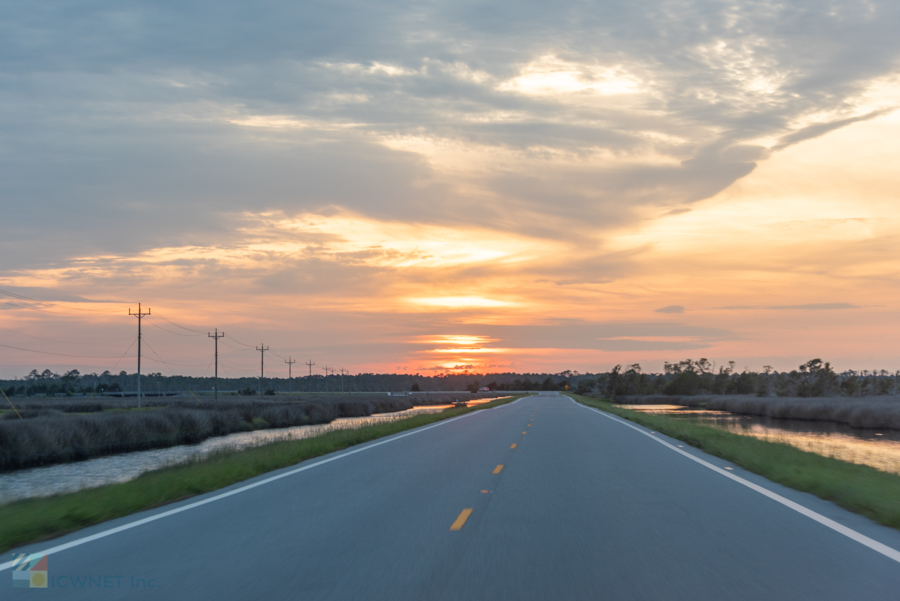Cedar Island is the closest mainland region to Ocracoke Island, and serves as the launching point for many Ocracoke visitors who arrive on the Outer Banks from the south, via the Cedar Island / Ocracoke Ferry.
Though isolated and unpopulated, Cedar Island is nevertheless a worthy day-trip on its own merit, thanks to its proximity to Portsmouth Island, its extensive wildlife refuge, exceptional fishing, and secluded soundside beaches.
About Cedar Island
Though not as prominent as neighboring Ocracoke Island, Cedar Island has a unique atmosphere that will appeal to nature lovers and coastal fans alike. The following facts outline the overall environment of this small, barely-mainland, coastal North Carolina region.
- Historians estimate that Cedar Island was originally populated with local Native Americans, and later by European Settlers in the 1700s, if not earlier.
- Cedar Island has a year-round population of about 350 residents. Most of the locals are fishermen or employees of local businesses, and / or the North Carolina Ferry System.
- There are also a handful of vacation rental homes along the Pamlico Sound for visitors who crave the NC coastline, but enjoy a quiet, and un-touristy setting.
- Cedar Island is about four miles long, and is technically separated from the rest of the mainland by the West Thorofare Bay and Thorofare Creek.
- A small "Cedar Island" village is located on the northern section of the island, close to the Ocracoke / Cedar Island Ferry, but the majority of the island is part of the undeveloped Cedar Island National Wildlife Refuge.
- The Cedar Island National Wildlife Refuge was established in 1964, and includes roughly 11,000 acres of marshlands and 3,480 acres of woodland and pocosin habitat.
- There are only two main roads that wind through Cedar Island, NC Highway 12, which runs through the length of the island, and Lola Road.
- Many visitors refer to "Cedar Island" as the group of communities and towns that are found along the pretty but sparsely populated region north of Beaufort and Morehead City. These towns include Atlantic, Sea Level, Stacy and Davis.

Visiting Cedar Island
The easiest way for Ocracoke visitors to get to Cedar Island is via the Cedar Island ferry, a 2.25 hour long ferry that crosses the Pamlico Sound. (Vehicular rates per crossing are around $15 for a standard, 2-axel car or truck without a trailer.) Visitors can reserve a spot on the ferry before their departure online at https://ferry.ncdot.gov/ or by calling 1-800-BY-FERRY. Advanced reservations are strongly encouraged, especially during the summer and on weekends, when traffic on and off the island is especially high.
Visitors from the southern mainland need only head north along NC Highway 12, past the Crystal Coast communities of Beaufort and Morehead City, to access Cedar Island.
While there are few amenities in Cedar Island, the region is home to a popular campground, a convenience store, and a small motel and restaurant. Both the campground and the motel have online websites for potential visitors.
The motel and restaurant is located adjacent to the Cedar Island Ferry Terminal, which makes it convenient for visitors who are planning an early morning departure on the Cedar Island ferry to Ocracoke, and who want to rest the night before. Advanced reservations are strongly encouraged at the motel, especially on summer weekends when the motel regularly books up with early morning ferry travelers.
Cedar Island is also approximately a 30 minute drive away from the major grocery stores, restaurants, and attractions of Beaufort and Morehead City.
Cedar Island Activities
Cedar Island is all about the great outdoors, and visitors can spend a day enjoying these commonly popular Cedar Island activities.
Boating - There are several public boat ramps on Cedar Island, including one on Lola Road, one adjacent to the Thorofare Bridge on NC Highway 12, and one to the east of the Ferry Terminal. From Cedar Island, vessels can cruise across the Core Sound to access Portsmouth Island and the Cape Lookout National Seashore.
Fishing - Fishing and crabbing are popular for visitors and locals alike, and while it's preferable to fish in the Pamlico Sound waters via a boat, visitors can cast out via the waterfront parking area next to the Thorofare Bridge.
Hunting - 400 acres of the Cedar Island National Wildlife are seasonally open for hunters, provided that proper permits have been acquired. Contact the Refuge office for more information and seasonal regulations at 252-926-4021.
Kayaking - The calm sound waters are ideal for kayaking, and launching points along the Thorofare Bridge and at the edge of Lola Road will make accessing the open waters an easy task.
Shelling - The wide soundside beaches close to the Cedar Island ferry terminal produce interesting finds for beachcombers, including weathered scallops, clams, oysters, and periwinkles. Many of these shells have effectively been buried for hundreds of years, which accounts for their stark-white appearance. Visitors can also take a boat trip across the sound to Portsmouth Island, which is renowned as one of the best shelling destinations in North Carolina.
Horseback Riding - The soundside beaches are perfect for horseback riding and a local horseback riding and stables center, Outer Banks Riding Stables, can be found adjacent to the Cedar Island ferry terminal Guided tours are seasonally available for visitors, and more information can be found online at http://www.horsebackridingonthebeach.com/.
Bird Watching and Wildlife Observation - Thanks to the thousands of undeveloped acres, the marshes and high grounds of the Cedar Island National Wildlife Refuge are a fantastic destination for bird watchers. Visitors can park at the handful of parking areas along NC Highway 12, (notably by the Thorofare Bridge which borders the marsh), to snap pictures of the shorebirds and migrating waterfowl. Keep a lookout for great blue herons, egrets, and ibises, which are common and striking sightings.






